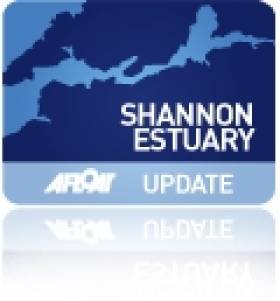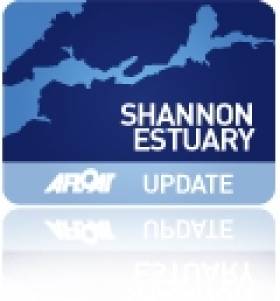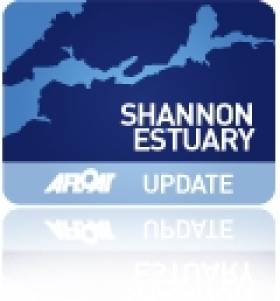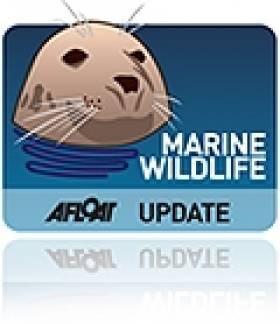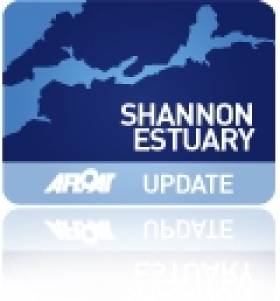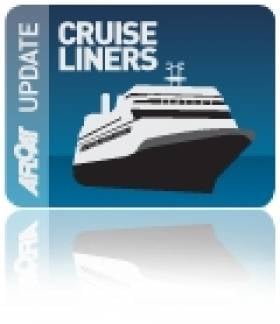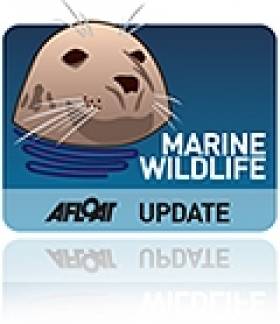Displaying items by tag: Shannon Estuary
#NewMaritimeMuseum – As previously reported, Shannon Foynes Port Company's master plan 'Vision 2041' looks forward to the future and soon the past will be explored when a new maritime museum opens next month, writes Jehan Ashmore.
It was at the launch of the masterplan at the Foynes Flying Boat Maritime Museum, where the new museum (opening 14 March) will be incorporated, to trace the rich history of the Shannon Estuary.
As the largest 'navigable' estuary (500km2) in Ireland and one of the deepest waterways in Europe, the museum will not just focus on shipping, but also the geology, personality and mythology of the estuary stretching from Limerick Docks down to Loop Head, marking the mouth of Shannon.
As previously reported, vessels such as the 82,562dwt London 2012, a dry bulk-carrier (Length: 229m X Beam: 32m X Draft: 14m) had docked at the Aughinish Alumina jetty last month.The port, which is Ireland largest bulk port company can handle larger vessels up to 200,000dwt, however under Vision 2041, the Shannon estuary is to cater for the World's largest container ships as the port is strategically located as a potential hub-port in Western Europe and creation of a 'Ocean Energy Hub'.
Its prime position is to take advantage of the new 'post-Panamax' sized super container ships and tankers under construction following the completion of the enlarged Central American canal linking the huge Asian market, notably from China and or via North America and onwards to Europe.
As these developments look to the future prospects of the estuary's ports, the past will not be forgotten as the flying boat museum with its replica aircraft based in Foynes, will have a new floor dedicated to exhibits. The diversity of topics on display in the maritime museum are listed below.
• The charts and maps of the river from the time of Ptolemy.
• The geology, tides and weather of the Shannon
• The pilots who raced in their rowing boats to be the first to guide large sailing ships up the estuary
• The dockworkers loading and unloading a vast range of cargo from ocean-going ships
• The "Spring-Rice Set" —the O'Briens, De Veres and Spring Rices, who owned large tracts of land on the shores of the river but who were actively concerned in the welfare of the less fortunate people around them
• The amazing record of ships on the river left to us by Murrogh O'Brien in the form of paintings and charts
• Different types of ships and boats used on the river
• The development of Foynes Port
• Navigation of the river including the many lighthouses that guided mariners up the river
• The tragic story of the Colleen Bawn
• The story of Transportation and emigration on the river.
• Tait's manufacture and export of uniforms to the American confederates during the Civil War.
• Display with Met Maps and audio visual on weather conditions.
• Story of the Windsor Castle Ghost Ship, sailed up the Shannon in 1843.
• Audio Visual on life on the River Shannon.
The maritime museum will be opened to the public from 14 March, 9am-5pm (visitors should try and arrive an hour before closing). For further details visit: www.flyingboatmuseum.com/
Master Plan for Shannon Estuary Launched
#Shannon - The Shannon Foynes Port Company has launched its master plan for the development of port infrastructure and services along the Shannon Estuary.
RTÉ News reports on the 30-year plan, titled Vision 2041, which will involve the construction of a new deepwater birth at Foynes, the development of warehousing and facilities across 300 acres of additional land - and the potential reopening of the Foynes-Limerick railway line, which has lain dormant since 2001.
As one of the deepest waterways in Europe, the estuary is also in prime position to take advantage of the new 'post-panamax' supertanker shipping era, and talks on securing future foreign direct investment as a priority.
As previously reported on Afloat.ie, submissions for the accompanying strategic plan for the development and management of marine-related industry and tourism in the Shannon Estuary region closed last week.
The Draft Strategic Integrated Framework Plan (SIFP) for the Shannon Estuary, the first of its type to be developed in Ireland, identifies a number of strategic sites along the estuary for future possible development in the areas of industry, tourism, energy, fishing and aquaculture and marine-related industry.
Time Called for Submissions to Shannon Estuary Plan
The agencies behind a major strategic plan for the future development and management of marine-related industry and tourism along the Shannon Estuary have advised that the closing date for submissions is this Friday (February 15th 2013).
#shannoestuary – The Draft Strategic Integrated Framework Plan (SIFP) for the Shannon Estuary has been commissioned by a multi-agency steering group comprising Clare County Council as lead authority, Kerry County Council, Limerick City and County Councils, Shannon Development and Shannon Foynes Port Company.
The land and marine-based plan, the first of its type to be developed in Ireland, indentifies a number of strategic sites along the Estuary for future possible development in the areas of industry, tourism, energy, fishing and aquaculture and marine-related industry.
A series of public consultations on the SIFP for the Shannon Estuary took place in Clare, Kerry and Limerick in late January. The Plan will remain on display until this Friday to give the public an opportunity to view the proposals and put forward their opinions to the appointed project consultants, RPS Consulting Engineers.
To coincide with the public consultation process an amateur photography competition is being held, the closing date for which has been extended to Friday, February 22nd, 2013. With two categories, 'Adult' and 'U18', photographs submitted can feature any aspect of the Estuary, including people, places, biodiversity, work and recreation activities.
On completion in late 2013, it is anticipated that the SIFP will be incorporated, by means of Variation, into the relevant County and City Development Plans in Clare, Limerick and Kerry. Further consultation with the public will take place as part of that statutory Variation process.
Shannon Estuary Plan to Develop Ireland's Second Biggest Port Goes to Public Consultation
#shannonestuary – The people of Clare, Kerry and Limerick are being invited to attend one of a series of public consultations on a major strategic plan for the future development and management of marine-related industry and tourism along Ireland's largest estuary, the Shannon Estuary.
The Draft Strategic Integrated Framework Plan (SIFP) for the Shannon Estuary was launched last month by Jan O' Sullivan, TD, Minister of State for Housing & Planning and has been commissioned by a multi-agency steering group comprising Clare County Council as lead authority, Kerry County Council, Limerick City and County Councils, Shannon Development and Shannon Foynes Port Company.
The land and marine-based plan, the first of its type to be developed in Ireland, indentifies a number of strategic sites along the Estuary for future possible development in the areas of industry, tourism, energy, fishing and aquaculture and marine-related industry.
Public consultations will take place at the offices of Kilrush Town Council in Co Clare on Monday 28 January, Tarbert Community Centre in Co Kerry on Tuesday 29 January, and Foynes Community Centre in Limerick on Wednesday 30 January (all times 4.30pm to 8.30pm). The events will feature presentations on the contents of the Draft Plan, while members of the public will also be able to discuss the Plan with local authority officials and representatives of the appointed consultants, RPS Consulting Engineers.
Meanwhile, the SIFP for the Shannon Estuary is also on display until February 15th 2013 to give the public an opportunity to view the proposals and put forward their opinions to the appointed project consultants, RPS Consulting Engineers. To coincide with the public consultation process an amateur photography competition has also been launched. With two categories, 'Adult' and 'U18', photographs submitted can feature any aspect of the Estuary, including people, places, biodiversity, work and recreation activities. Further details may be obtained from www.shannonestuarysifp.ie
According to Tom Coughlan, Clare County Manager and Chairman of the Steering Group: "The key objective of the SIFP is to research and develop an integrated approach to facilitating economic growth and promoting environmental management within and adjacent to the Shannon Estuary. The process represents the development and implementation of first Strategic Plan for the entire Shannon Estuary including the lands immediately adjacent to the Estuary."
On completion later this year, it is anticipated that the SIFP will be incorporated, by means of Variation, into the relevant County and City Development Plans. Further consultation with the public will take place as part of that statutory Variation process.
London 2012 Weighs Anchor off World Famous Golf Course
#OLYMPIC SHIP - A 82,562 dwt dry bulk-carrier, London 2012, weighed anchor today having recently docked at the Aughinish Alumina jetty, on the Shannon Estuary, writes Jehan Ashmore.
The Liberian flagged vessel which has a draft of more than 14m had docked at Aughinish, one of six terminals operated by Shannon Foynes Port Co, near Askeaton, Co. Limerick. The facility is where large sized ships can reach by plying the deep waters of the mid-western waterway that has some 500sq km of navigable estuary.
Following completion of operations of London 2012 at the Aughinish terminal, which is the largest alumina refinery in Europe, the vessel departed the jetty dedicated to importing bauxite to the Russian owned RUSAL plant, and proceeded to anchorage beyond the mouth of the Shannon.
The 229m long X 32m beam vessel had anchored some 3 nautical miles offshore of Ballybunion. The west Kerry venue is another place strongly associated with sport through its world famous golf course, situated on a spectacular stretch of coastline overlooking the Atlantic Ocean.
London 2012 and her sister Beijing 2008, belong to a fleet of approximately 70 vessels, totalling a capacity of 8 million deadweight tons (dwt) and are managed by Tsakos Columbia Shipmanagement (TCM) S.A. of Greece.
The Athens based TCM was only established in July 2010, as a joint venture between Tsakos Shipping and Trading S.A. and Schoeller Holdings Ltd, the owner and operator of Columbia Shipmanagement Ltd.
No doubt her Greek owners will make an opportunity for a vessel to continue in the Olympic spirit by sporting the name Rio de Janeiro 2016. As for golf fans, they too can look forward to the return of the sport in these Games.
Masterplan Sets Out 30 Year Vision for Ports on Shannon Estuary
#SHANNON PORTS- A draft masterplan Vision 2041, to develop port infrastructure and services for the Shannon Estuary over the next three decades, has been published by Shannon Foynes Port Company (SFPC).
The masterplan for Ireland's second largest port which has six terminals along the 500sq km navigable estuary, has specifically targeted growth and expansion options. Also identified are capacity and associated port infrastructure requirements, where SFPC has called for improved road and rail access.
In addition the masterplan is to take into consideration of non-core assets facilities at Foynes Port and Limerick Docks which consists of the single (Ted Russell) Dock basin.
Vision 2041 recognises the strategic need of the estuary to be in position to ensure future capability in handling larger trade volumes efficiently and competitively when the opportunities arise.
The masterplan has concentrated in identifying three key major objectives:
Significant expansion and infrastructural development in the deepwater Port of Foynes
Promoting non-core assets in Limerick Docks for alternative port / non port related activities
Managing the natural attributes of the estuary and its destination as an Ocean Energy Hub
The objectives of Vision 2041 are to realise the economic potential of the natural resource along the Shannon Estuary and developing positive promotion of the ports as a strategic economic driver for the Mid-West Region.
Copies of the SFPC Vision 2014 masterplan can be downloaded from clicking this LINK or alternatively a digital copy can be requested by contacting the Masterplan Team at 069 73100. The deadline for written submissions concerning the draft Masterplan is up to and incl. 1st February, see website for postal address and email details.
Dolphins Make a Noise in the Shannon Estuary
#Dolphin - YouTube user Karl Grabe from Cork has uploaded this wonderful snippet of dolphins vocalising in the Shannon Estuary.
The audio comes from the website for Listening to the Deep Ocean Current (LIDO), which collects a number of live hydrophones collecting the sounds of dolphin activity and other marine wildlife in locations around the world.
Foynes Yachts Take Line Honours in Cappa Race
#foynes – The last long race of the Foynes Yacht Club season took place last Sunday to the Clare coastal village of Cappa for members of Foynes Yacht Club writes Gerry Ryan.
The Officer of the Day, Ger Reidy sent the fleet from Cooleen Point racing at 10am.
A total of nine yachts took this scenic race on the Shannon Estuary, where as you near Cappa, the monastic Scattery Island, Loop Head and Carrigaholt can be seen.
Crews were mixed on the different vessels, with teenagers from the sailing school and adults competing.
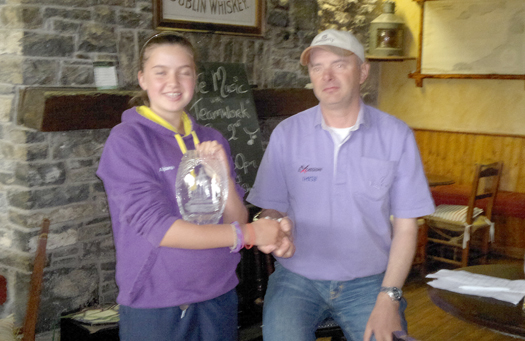
Crew member of Alpara, Mary McCormack receives the Sean Keating trophy
Unfortunately, skippers had to contend with light south-westerly winds, which took the vessels that bit longer to reach their destination.
The trophies that were raced for were the Galleon Cup and the Sean Keating trophy.
The yacht Battle were victorious on corrected time to win the Galleon Cup; second was John Conway on Golden Kopper and third, Team Foynes on Dexterity.
For the White Sails division, who were racing for the Sean Keating trophy, James McCormack on Alpara took line honours with closely followed in second by Pat Finucane on Marengo and third, Jessica Leigh.
At the presentation of prizes in the Galleon Inn, sailing captain, Liam Madden thanked all the participants who took part in the first race of the September series.
Racing continues every Sunday for the month with first gun at 2pm. Crews are asked to be at the marina at 1pm.
P&O Cruises Adonia Calls to Foynes
#SHANNON CRUISECALL – P&O Cruises Adonia is visiting the mid-west port of Foynes on the banks of the Shannon port today, writes Jehan Ashmore.
She had made a call to the east coast last week in Dublin Port and the 30,277 tonnes vessel is the second caller so far this year to visit the Shannon region, when the ultra-luxurious Silver Whisper docked in the Co. Limerick port in mid-May.
A further two cruise callers are scheduled, as Le Diamant is also due to call this week on Thursday. The final caller is Amadea, which is expected to close the season next month.
All cruise callers will dock in Foynes which is one of six port facilities along the Shannon Estuary which is under the control of the Shannon Foynes Port Company (SFPC).
Dolphin Group Celebrates Ireland's First Refloating Success
#MARINE WILDLIFE - A stranded dolphin has been successfully refloated for the first time ever in Ireland thanks to the efforts of volunteers with the Irish Whale and Dolphin Group (IWDG).
As the Irish Examiner reports, the group was alerted by a woman who saw the 3.5-metre bottlenose dolphin on a beach at Béal on the Shannon Estuary in north Kerry on 1 June.
Volunteers on the scene discovered the female dolphin's skin was still moist, which indicated it had only recently stranded.
After checking for injuries, the team decided not to wait for special whale pontoons to arrive from Kilrush and instead used a local farmer's tractor and low loader to lift the dolphin out of the sand.
The dolphin was slowly moved back to the water, where she was stabilised before she regained composure and was able to swim away.
Images of the dolphin's dorsal fin were captured by the volunteers for the IWDG's records, which enabled researchers to confirm subsequent sightings among a pod of some 140 dolphins swimming in the estuary - with the latest spotting on 27 June on a dolphin-watching boat trip, where she appeared to be in good health.
In a statement, the IWDG said: "The loss of one dolphin, especially an adult female, could have a significant impact on this population, thus highlighting the importance of the prompt action on the shore at Béal."



























